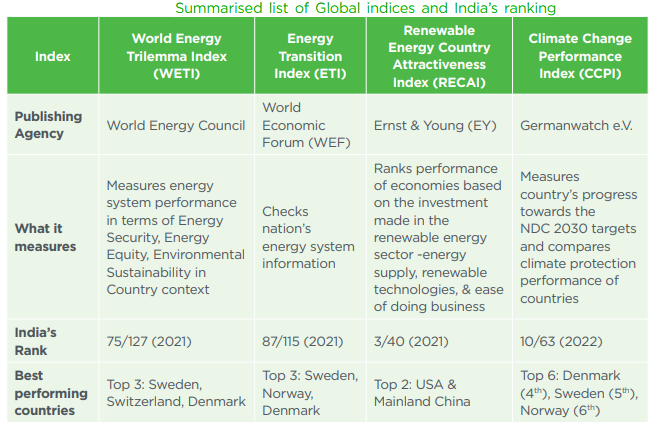For Prelims: Global climate indices and India’s Ranking, State Energy and Climate Index, NITI Aayog.
Why in News?
Recently, the NITI Aayog launched the State Energy and Climate Index (SECI). It is the first index that aims to track the efforts made by states and UTs in the climate and energy sector.
-
The parameters of the index have been devised keeping in mind India’s goals for climate change and clean energy transition.
What are the Key Points of SECI?
-
Objectives: The objectives of the index are:
-
Ranking the States based on their efforts towards improving energy access, energy consumption, energy efficiency, and safeguarding the environment.
-
Helping drive the agenda of the affordable, accessible, efficient and clean energy transition at the State level,
-
Encouraging healthy competition among the states on different dimensions of energy and climate.
-
Parameters: The State Energy and Climate Index (SECI) ranks states and UTs on six parameters:
-
Discoms' (Power distribution companies) Performance,
-
Access Affordability And Reliability Of Energy,
-
Clean Energy Initiatives,
-
Energy Efficiency,
-
Environmental Sustainability,
-
New Initiatives.
-
Categorization: Based on the outcome of SECI scores, states and union territories have been categorised into three groups -- front runners, achievers, and aspirants.
-
Top Performers: Gujarat, Kerala and Punjab have been adjudged as top three performer states in the NITI Aayog’s SECI.
-
The top three performers among smaller states are Goa, Tripura and Manipur.
-
Unsatisfactory Performance: States like Chhattisgarh, Madhya Pradesh and Jharkhand were placed at the bottom.

-
Need: India is a resource-rich and diverse country. Many of its states are comparable to countries in the European Union in terms of area, population, and diversity of resources.
-
Thus, a one-size-fits-all approach will not be appropriate as each state and Union Territory (UT) differ in terms of culture, geography, and use of energy resources.
-
It is imperative for each state and UT to have its own policy to harness its potential and capability.
What are India’s Climate Change Commitments?
-
The Prime Minister of India at the COP-26 Glasgow summit presented five nectar elements, Panchamrit, to deal with climate change:
-
India will reach its non-fossil installed electricity capacity to 500 GW by 2030.
-
India will meet 50% of its electricity requirements from renewable energy by 2030.
-
India will reduce the total projected carbon emissions by one billion tonnes from now onwards till 2030.
-
By 2030, India will reduce the carbon intensity of its economy by less than 45%.
-
By the year 2070, India will achieve the target of Net-zero.
